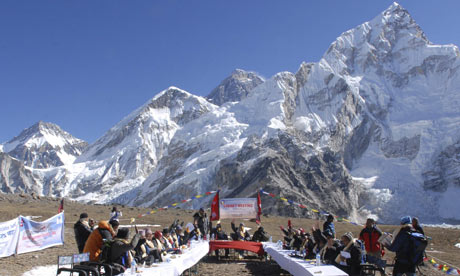- Twitterers, blogging activists and other interest groups will outnumber the media at the world climate change summit in Copenhagen

- The Guardian, Monday 7 December 2009

Ahead of Copenhagen 2009, Nepal's prime minister, Madhav Kumar Nepal (centre), chairs his cabinet's meeting at Kalapathar, below Mt Everest and 5542m above sea level, to raise awareness of the effects of climate change. Photograph: Narendra Shrestha/EPA
In the next fortnight 5,000 journalists from 180 countries will go to Copenhagen to cover the world climate summit. There might have been far more, but two weeks ago the UN had to close its accreditation list ahead of a meeting for the first time, saying that the giant Bella venue could only hold 15,000 people. Cop 15, as it is formally known, will therefore be one of the biggest-ever international media occasions outside the 2008 Olympics and the last US conventions.
It's a measure of how the environment has risen up the global agenda that the last great UN green show attracted a modest 1,000 press and TV to the more hospitable venue of Rio de Janeiro in 1992. In those days, when climate change was a mere infant in world politics and angry science deniers hardly existed, newspapers and television mostly sent one person to the earth summit. The Guardian was considered reckless for sending two specialists from Britain, and co-opted its local Brazilian correspondent. A US-based writer later flew in with President George Bush Sr, and the Guardian newsdesk, which barely understood what emissions were, bravely ran four or five pieces a day until collective incomprehension set in about Day 7.
Legions of bloggers
This year's summit, widely hyped as the most important meeting in the last 30 years, is a multimedia affair. The BBC is sending 35 people and the Guardian a team of eight, including environment correspondents from Beijing and Washington (emissions duly offset). And every newspaper is sending online journalists, bloggers, video and audio journalists, producers, analysts and Twitterers.
For the first time, too, many developing countries will send journalists in force. Normally barred from media fests such as this by the sheer cost, governments, media foundations, Commonwealth organisations and development groups such as Panos have funded several hundred writers and filmmakers from countries on the frontline of climate change to follow the talks. China, India and Brazil, the three great emerging nations, will be sending nearly 300 journalists.
In the UN list of 5,000, however, mainstream media representatives are outnumbered by people representing the publications of charities, pressure groups, business interests and non-government organisations. Churches, financiers, wind farm operators, fossil fuel industries, even carbon traders have all gained media accreditation to further their lobbying. New on the block are legions of youth activists from around the world who will be blogging on a scale never experienced at an international political meeting.
Yet pity the mainstream press. Their choice is stark: stay outside the Bella centre, pay £6 for a cup of tea and cover rallies, demonstrations and fringe meetings in the freezing cold; or keep warm inside, pay £7 for tea and asphyxiate in the hot, poisonous air generated by armies of diplomats and non-government groups.
What all first-timers to the UN climate process may find hard to grasp at Copenhagen is that this could be the only mass media event in history without a proper beginning or an end, which has no genuine celebrities, no fixed agenda, no guaranteed outcome and is unlikely to throw up clear winners or losers. It's like a cricket Test match in that the rules of the diplomacy game are complex, most meetings are supremely boring, very little may happen for many days and it is all conducted in incomprehensible UN-speak language.
The problem is getting anywhere near the truth. Most countries do their diplomacy in private and do not want anyone – let alone the press – to know what goes on in the negotiations. Beyond that, the talks are so technical that few can understand them even if they are explained. Moreover, meetings are closed, all decisions are dependent on others and are made in secret, the UN secretariat is opaque, the diplomats and negotiators are unaccountable and speak in code, and because of the insane complexity of the negotiations, there is probably only a handful of people who actually understand what is happening at any moment. The drama at the very end when world leaders start their horse-trading will be genuinely dramatic, but no one will actually see it take place.
The UN is partly to blame for this opacity and the paucity of genuine information. Press conferences where blocs of countries assess the proceedings are infrequent and kept to a few short questions; many countries have no experience with the media; everyone briefs against everyone else and because diplomats are famously partial and are paid to lie for their countries, and objective facts are in short supply.
None of this will stop tonnes of copy being sent back. There will be set pieces, sideshows and photo opportunities galore, such as Obama flying in for a few hours to give an inspirational speech tomorrow then heading on to collect the Nobel peace prize. When the 100 world leaders come in a week later, they are likely to be met with profound weariness if they try to compete with each other to be seen as the greenest.
But there could still be drama. The poorest countries in the world could walk out in protest if the talks do not go to plan; the Danish model Helena Christensen could strip off and swim in the Baltic. Climate activists are also plotting.
More likely, climate deniers from Britain and the US will gain a rare platform to attack the science of climate change. Nick Griffin of the BNP will be there, as will several contrarian US senators.
However, the vast majority of bloggers and delegates believe in man-made climate change and any deniers will be very much on the fringes outside the hall. Against them will stand the scientific community, sherpas testifying to profound change in the Himalayas the young and President Nasheed from the Maldives explaining that his country will soon not exist, and activists intent on grabbing the stage.
Gore's prescience
Environment journalism has come a long way since 1975 when Geoffrey Lean – then of the Observer, now of the Telegraph – became the first dedicated correspondent. Before that, the brief was mostly given to correspondents who shadowed the government's rural affairs or farming department. The beat still covers traditional areas such as floods, spuds and trees, but it is now centred on science writing, international development and politics, energy, technology, economics, celebrity and lifestyle, as well as business, trade and protest. And because it crosses so many traditional journalistic boundaries, it has become a specialist area that suits generalists. Equally, there is no specialist political, business or feature writer who does not now regularly report on the environment. To paraphrase Al Gore, we are all environment journalists now.
Monday, December 7, 2009
Copenhagen media coverage: A perfect storm
Subscribe to:
Post Comments (Atom)
No comments:
Post a Comment